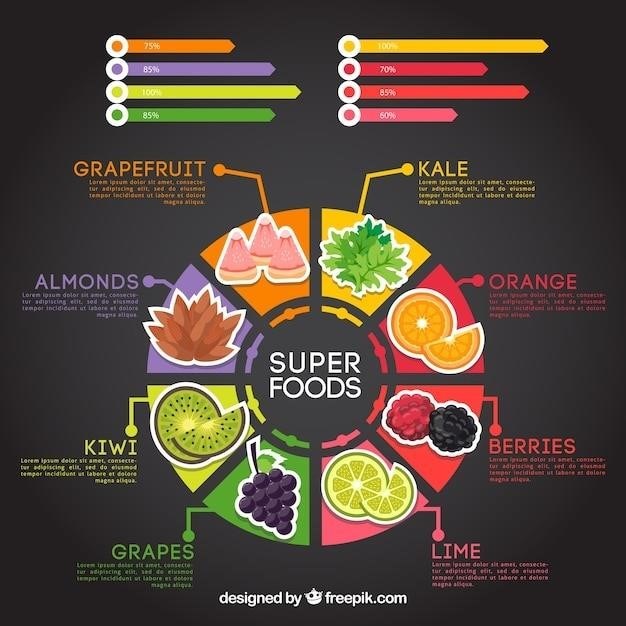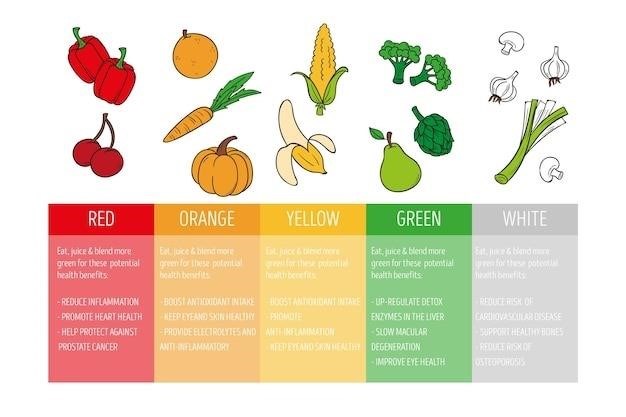Aliments Riches en Fer⁚ Tableau PDF
This PDF table lists a wide range of foods rich in iron, categorized by type and ranked in descending order of iron content. It provides valuable insights for individuals seeking to increase their iron intake, especially those with iron deficiency or anemia. The table also includes information on iron absorption factors, highlighting the importance of consuming vitamin C-rich foods alongside iron-rich sources.
Introduction
Iron is an essential mineral that plays a crucial role in numerous bodily functions, including oxygen transport, energy production, and cell growth. Iron deficiency, also known as anemia, is a common health concern, particularly among women of childbearing age, infants, and young children. A balanced diet rich in iron-containing foods is crucial for maintaining adequate iron levels and preventing iron deficiency. This comprehensive PDF table serves as a valuable resource for individuals seeking to identify and incorporate iron-rich foods into their daily meals. The table provides a detailed overview of various food sources of iron, categorized by type and ranked by iron content, making it easy to choose foods that can effectively contribute to meeting individual iron needs.
Importance du Fer
Iron is an essential mineral that plays a vital role in numerous bodily functions, including oxygen transport, energy production, and cell growth. It is a key component of hemoglobin, the protein found in red blood cells responsible for carrying oxygen from the lungs to the rest of the body. Adequate iron levels are essential for maintaining good health and preventing iron deficiency, also known as anemia. Anemia can lead to fatigue, weakness, shortness of breath, and other symptoms. Iron is also crucial for the development and function of various enzymes and proteins involved in immune system function, DNA synthesis, and other vital processes.
Iron deficiency is a common health concern, particularly among women of childbearing age, infants, and young children. Individuals with certain medical conditions, such as chronic kidney disease or inflammatory bowel disease, may also be at increased risk of iron deficiency. A balanced diet rich in iron-containing foods is crucial for maintaining adequate iron levels and preventing iron deficiency. This PDF table provides a detailed overview of various food sources of iron, categorized by type and ranked by iron content, making it easy to choose foods that can effectively contribute to meeting individual iron needs.
Sources de Fer⁚ Héminique vs Non-Héminique
Iron is found in two main forms within food⁚ heme iron and non-heme iron. Understanding the difference between these forms is crucial for maximizing iron absorption from your diet. Heme iron, found primarily in animal sources like meat, poultry, and fish, is more readily absorbed by the body compared to non-heme iron. This is because heme iron is bound to a molecule called porphyrin, which makes it easier for the body to absorb. Non-heme iron, on the other hand, is found in plant-based sources such as legumes, grains, vegetables, and nuts. This type of iron is less efficiently absorbed by the body, and its absorption can be influenced by various factors, including the presence of other nutrients and substances in the diet.

For those aiming to increase their iron intake, focusing on both heme and non-heme sources is essential. This PDF table provides a comprehensive list of foods rich in both types of iron, allowing you to make informed choices about your dietary iron intake. The table categorizes foods by their iron content and source, making it easy to identify foods that can effectively contribute to meeting your individual iron needs. By incorporating a variety of iron-rich foods from both animal and plant sources into your diet, you can ensure adequate iron absorption and support optimal health and well-being.
Aliments Riches en Fer Héminique
Heme iron, the form of iron found in animal-based foods, is more readily absorbed by the body compared to non-heme iron. This PDF table highlights a variety of foods rich in heme iron, providing valuable insights for individuals looking to increase their iron intake through animal sources. These foods are categorized by their iron content, making it easy to identify those with the highest concentrations.
The table includes a diverse range of heme iron-rich foods, from red meat and poultry to seafood and organ meats. For example, it features foods like liver, kidneys, heart, and spleen, known for their exceptionally high iron content. Additionally, the table showcases various types of meat, including beef, lamb, rabbit, and game, as well as different seafood options such as oysters, mussels, and clams. By incorporating these foods into your diet, you can effectively increase your heme iron intake, supporting optimal iron levels and overall health.
The table serves as a valuable tool for individuals seeking to meet their iron needs through heme-rich foods. It allows you to make informed decisions about your dietary choices, ensuring you are consuming a variety of foods that provide ample heme iron for optimal health.
Aliments Riches en Fer Non-Héminique
This PDF table presents a comprehensive list of foods rich in non-heme iron, a form of iron found in plant-based sources. While non-heme iron is less readily absorbed compared to heme iron, it still plays a crucial role in maintaining adequate iron levels. The table categorizes these foods by their iron content, making it easier to identify those with the highest concentrations.
The table includes a wide range of non-heme iron-rich foods, from legumes and nuts to grains and vegetables. For example, it features lentils, beans, chickpeas, and soybeans, all known for their significant iron content. It also includes various nuts and seeds, such as pumpkin seeds, pistachios, and cashews, as well as fortified cereals and grains like oatmeal and whole-wheat bread. Vegetables like spinach, kale, and Swiss chard, are highlighted for their contribution to non-heme iron intake.
The table also emphasizes the importance of consuming foods rich in vitamin C alongside non-heme iron sources to enhance absorption. Fruits like oranges, grapefruits, and strawberries, as well as vegetables like broccoli, bell peppers, and Brussels sprouts, are listed as excellent sources of vitamin C. By incorporating these foods into your diet, you can effectively increase your non-heme iron intake and improve its absorption, promoting optimal iron levels and overall health.
Facteurs Améliorant l’Absorption du Fer
This PDF table provides valuable insights into factors that enhance iron absorption, a crucial aspect of maintaining optimal iron levels. The table highlights the synergistic relationship between iron and vitamin C, emphasizing that consuming vitamin C-rich foods alongside iron-rich sources significantly improves iron absorption.
The table lists several examples of vitamin C-rich foods, including citrus fruits like oranges, grapefruits, and lemons, as well as other fruits like strawberries, blueberries, and kiwi. It also includes vegetables like broccoli, bell peppers, and Brussels sprouts, all known for their high vitamin C content. The table encourages incorporating these foods into meals alongside iron-rich sources to maximize iron absorption.
Furthermore, the table suggests consuming iron-rich foods with sources of heme iron, such as lean meats, poultry, and fish. Heme iron is more readily absorbed than non-heme iron, and its presence in a meal can enhance the absorption of non-heme iron from plant-based sources. This information is crucial for individuals seeking to optimize iron absorption, particularly those with iron deficiency or anemia. The table serves as a practical guide for making informed dietary choices to support iron absorption and overall health.
Facteurs Inhibant l’Absorption du Fer
This PDF table sheds light on factors that hinder iron absorption, providing valuable information for individuals aiming to maximize iron intake. The table emphasizes the impact of certain beverages and foods on iron absorption, highlighting the importance of mindful dietary choices.
The table specifically mentions the inhibitory effects of tannins found in tea, coffee, and wine. These compounds bind to iron in the digestive tract, reducing its absorption. The table advises against consuming these beverages concurrently with iron-rich meals.
Additionally, the table highlights the impact of dairy products on iron absorption. The calcium in dairy can interfere with the absorption of non-heme iron, found in plant-based sources. However, it’s important to note that this interaction is less significant when consuming heme iron from animal sources. The table suggests spacing out dairy consumption from iron-rich meals to minimize this inhibitory effect. By understanding these factors, individuals can make informed dietary choices to optimize iron absorption and support their iron levels.
Tableau des Aliments Riches en Fer
This comprehensive PDF table provides a detailed breakdown of iron content in various foods, categorized by food group and ranked in descending order. This invaluable resource serves as a practical guide for individuals seeking to incorporate iron-rich foods into their diet. It allows for a clear visualization of the iron content in different food options, enabling informed choices for optimal iron intake.
The table includes a wide array of foods, encompassing meat, poultry, fish, seafood, legumes, vegetables, fruits, grains, and nuts. It presents the iron content in milligrams per 100 grams of each food, offering a standardized comparison for easy reference. The table also incorporates information on the absorption coefficient for each food, highlighting the varying bioavailability of iron from different sources.
This detailed breakdown of iron content across diverse food groups empowers individuals to make informed dietary choices, ensuring sufficient iron intake for optimal health and well-being. The table’s user-friendly format and comprehensive information make it a valuable tool for individuals seeking to address potential iron deficiencies or maintain adequate iron levels.
Conseils pour Augmenter l’Apport en Fer
Boosting your iron intake requires a strategic approach that goes beyond simply consuming iron-rich foods. This involves understanding the factors that enhance or hinder iron absorption.
One key strategy is to pair iron-rich foods with vitamin C-rich sources. Vitamin C, found in citrus fruits, berries, and bell peppers, improves the absorption of non-heme iron, which is prevalent in plant-based foods. Incorporating these foods together can significantly increase the iron your body can utilize.
Conversely, certain substances can hinder iron absorption. Avoiding excessive tea, coffee, and red wine consumption during meals is crucial, as their tannins can inhibit iron uptake. Additionally, consuming foods high in calcium, such as dairy products, alongside iron-rich meals may interfere with iron absorption.
Furthermore, consider incorporating iron-rich foods into your diet regularly. This could involve incorporating lean red meat, poultry, fish, lentils, spinach, and fortified cereals into your meals. Remember, a balanced diet rich in diverse iron sources, coupled with the right food pairings, can effectively increase your iron intake.
Maintaining adequate iron levels is crucial for overall health, particularly for individuals prone to iron deficiency or anemia. This PDF table serves as a comprehensive guide to iron-rich foods, offering a valuable resource for individuals seeking to improve their iron intake.
By understanding the various sources of iron, both heme and non-heme, and the factors influencing absorption, individuals can make informed dietary choices to optimize their iron intake. Remember, a balanced diet that includes diverse iron sources alongside vitamin C-rich foods can effectively address iron needs.
However, it is essential to consult a healthcare professional for personalized advice. They can assess individual needs, diagnose any underlying iron deficiencies, and recommend appropriate dietary strategies or supplements, if necessary.
With a balanced approach that combines dietary adjustments, lifestyle modifications, and professional guidance, achieving optimal iron levels can be readily attainable.

0 comments on “aliments riches en fer tableau pdf”Add yours →